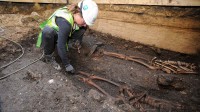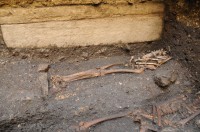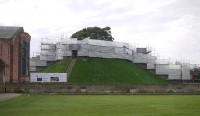 Archaeologists excavating Lincoln Castle as part of a major refurbishment project have unearthed the remains of a stone church and burials pre-dating the Norman invasion and the construction of the castle. A total of eight skeletons have been found thus far, all buried in the east-west alignment that is typical of Christian burials. The remains of walls and flooring suggest this was a religious structure in which people of high status would be buried rather than a cemetery. Pottery found at the same level dates to the 10th century, which means the church and burials are around a century older than Lincoln Castle, which was one of the first castles built in England by William the Conqueror in 1068.
Archaeologists excavating Lincoln Castle as part of a major refurbishment project have unearthed the remains of a stone church and burials pre-dating the Norman invasion and the construction of the castle. A total of eight skeletons have been found thus far, all buried in the east-west alignment that is typical of Christian burials. The remains of walls and flooring suggest this was a religious structure in which people of high status would be buried rather than a cemetery. Pottery found at the same level dates to the 10th century, which means the church and burials are around a century older than Lincoln Castle, which was one of the first castles built in England by William the Conqueror in 1068.
The spot 10 feet under ground level was being surveyed before construction of an elevator shaft when archaeologists encountered multiple skeletons and two stone walls. Further excavation in the small space — it’s approximately 10 by 10 feet — revealed another skeleton which had once been wrapped in a finely woven fabric buried in a niche in the foundations of the oldest wall. The textile has long since disintegrated, but the imprint of it is still visible in the wall’s mortar. This unusual burial within a wall suggests the remains may be the relics of a saint or august venerated personage of some kind who was inhumed in the foundations as a votive deposit to sanctify and dedicate the building.
 They also found a limestone sarcophagus with the lid mortared in place. Archaeologist Cecily Spall of FAS Heritage was able to peer inside the coffin using an endoscopic camera and saw a complete articulated skeleton within. Anglo-Saxons didn’t, as a rule, make sarcophagi. This is probably a Roman one that was re-used. That was a not uncommon practice for early English Christians in the centuries after the collapse of Roman Britain, but it’s highly unusual to see a stone sarcophagus in a late Saxon burial.
They also found a limestone sarcophagus with the lid mortared in place. Archaeologist Cecily Spall of FAS Heritage was able to peer inside the coffin using an endoscopic camera and saw a complete articulated skeleton within. Anglo-Saxons didn’t, as a rule, make sarcophagi. This is probably a Roman one that was re-used. That was a not uncommon practice for early English Christians in the centuries after the collapse of Roman Britain, but it’s highly unusual to see a stone sarcophagus in a late Saxon burial.
Judging from the dimensions and location of the walls, Spall believes the church was about 23 feet by 13 feet, which if accurate, would place the sarcophagus right in the middle of the structure. The sweet spot, if you will, where only the most important people would be buried. The other skeletons were buried in wooden coffins, less dramatic than the sarcophagus, but still an indication of wealth and rank.
It’s a highly significant find: an unrecorded church with high status burials underneath Lincoln Castle. The earliest Christian church was built in Lincoln in the 7th century by one Blaecca whom Bede describes (Ecclesiastical History of the English Nation, Book II, Chapter XVI) as the praefectus Lindocolinae civitatis, the main city official whose high title may indicate he was related to the royal family in addition to having been appointed city magistrate by King Edwin of Northumbria. That church, named St. Paul in the Bail after Saint Paulinus who brought Christianity to Lincoln and converted Blaecca and his family, was built in the former Roman forum near what is now the northeastern corner of the castle.
That church was demolished in the 14th century, but there is evidence that a body buried in the 7th century church was removed in the 10th century and buried somewhere else. Until now historians have assumed it was reburied in the late Saxon church underneath the 11th century Lincoln Cathedral, but perhaps that somewhere is else was the small but noble-packed church on the site of the future castle.
The skeletons will be analyzed by osteologists to determine their age, sex, place of birth, diet, lifestyle and possibly their cause of death. They will also be radiocarbon dated. After the scientific examination, the remains will go on display at The Collection archaeological museum in Lincoln. Meanwhile, visitors are welcome to visit the castle and observe the excavation work.
 Lincoln Castle is undergoing an ambitious £19.9 million ($30 million) expansion of its visitor facilities. The walls are being repaired complete with disabled access (hence the elevator shaft) so people can walk the full circuit of them. There will be a new visitors center and a vault that will house Lincoln’s copy of the original Runnymede Magna Carta, one of only four known to exist. The hope is construction will be completed in time for the 800th anniversary of Magna Carta in 2015.
Lincoln Castle is undergoing an ambitious £19.9 million ($30 million) expansion of its visitor facilities. The walls are being repaired complete with disabled access (hence the elevator shaft) so people can walk the full circuit of them. There will be a new visitors center and a vault that will house Lincoln’s copy of the original Runnymede Magna Carta, one of only four known to exist. The hope is construction will be completed in time for the 800th anniversary of Magna Carta in 2015.
I trust they’ll all be given a traditional Catholic re-burial?
By British law, they have to be respectfully reburied, but I don’t think the denomination is stipulated. In the past, modern religious communities have independently held ceremonies and memorials marking reburials. Contemporary pagans have been particularly vocal about claiming ancient remains.
Thanks for amazing blog :)…
There were at least Romans, Britons, Anglo-Saxons, by the 9th century Danes and then Normans. What really hits me is that apparently no parking lots have been involved so far.
😆
I wonder just how much Roman building material was ‘recycled’ by the Anglo-Saxons. Anglo-Saxon Britain must have resembled a post-WW2 bomb site of Roman ruins.
I don’t know if there’s any way to quantify the rate of reuse, but yeah, it was probably big. There are only three known Roman settlements in England that were never built over by later inhabitants: Venta Icenorum, Silchester and Wroxeter Roman City.
Bede mentions the burial of Aethelthryth of Ely (St Etheldreda, St Audrey) in a Roman sarcophagus (taken from Roman Cambridge) in the seventh century. Your post mentions a saint translated from the 7th century church to somewhere else in the 10th century. i wonder if the saint was moved complete with sarcophagus? Your post doesn’t mention the gender of the skeleton. Will be interesting to see what further tests reveal.